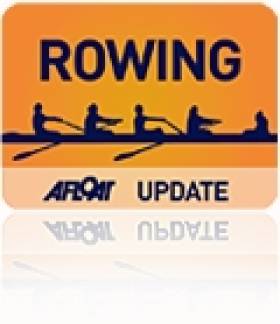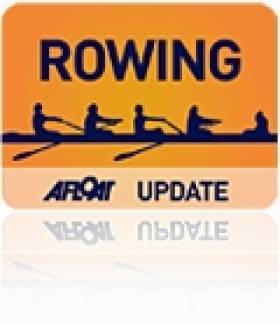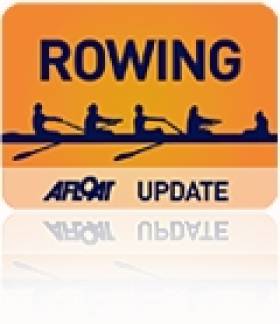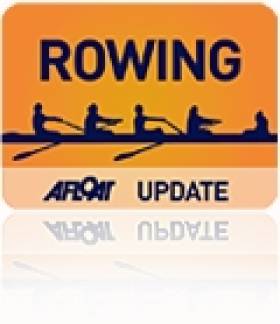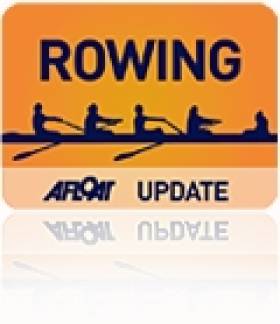Displaying items by tag: Colaiste Iognaid
Eights Wins for Galway Boys at Irish Schools Regatta
#Rowing: St Joseph’s of Galway won both the junior 16 and junior 15 boys’ eights at the Irish Schools Rowing Regatta at O’Brien’s Bridge. Another Galway school, Coláiste Iognáid, took the girls’ junior 15 eight. Presentation of Cork were the fastest crew in the men’s under-23 coxed four. There was a good spread of wins through the island of Ireland.
Irish Schools Regatta 2015, O’Brien’s Bridge, Selected Results
Men
Eight – Junior 16: 1 St Joseph’s, 2 Col Iognáid, 3 Presentation, Cork. Jun 15: 1 St Joseph’s, 2 Pres, Cork, 3 Portora.
Four – Under-23, coxed: 1 Pres, Cork, 2 St Joseph’s, 3 CBS, Cork. Junior 15, coxed: 1 St Joseph’s A, 2 Portora, 3 Presentation Cork.
Pair – Under-23: 1 Portora A, 2 St Joseph’s B, 3 Ardscoil A.
Sculling
Quadruple – Junior 16, coxed: 1 Ardscoil A, 2 Methody, 3 Killorglin. Jun 15, coxed: 1 CBC Cork A, 2 CAI, 3 Methody.
Double – Under-23: Schull CS A, 2 Marist, 3 Summerhill. Junior 16: 1 Rochestown, 2 Methody, 3 Pres, Carlow. Jun 15: 1 St Mary’s, Carlow, 2 CBC, Cork, 3 Castleknock.
Single – Under-23 (Final One, Timed): 1 Waterpark (Goff), 2 St Munchin’s (Carmody), 3 Rochestown (Larkin). (Final Two, Timed): Portora (Murray).
Women
Eight – Junior 15: 1 Col Iognáid, 2 Enniskillen
Four – Under-23: 1 Enniskillen, 2 Mount Lourdes. Jun 16, coxed: 1 Col Iognáid B, 2 Enniskillen, 3 Col Iognáid A. Jun 15, coxed: 1 Col Iognaid, 2 Mount Lourdes.
Pair – Under-23: 1 Enniskillen, 2 Laurel Hill B, 3 Laurel Hill A.
Sculling
Quadruple – Junior 16, coxed: 1 Gaelcholáiste Cheatharlach, 2 Regina Mundi, 3 St Leo’s.
Double – Under 23 (Final One, Timed): 1 St Angela’s, Cork, 2 Methody, 3 Ursuline, Sligo. Final Two, timed: Sacred Heart. Final Three, timed: St Leo’s B. Jun 16: St Dominic’s, 2 Sacred Heart, 3 Christ the King A.
Single – Under-23: 1 Gael Lmk (Murphy), 2 Christ the King (Cummins), 3 Methody (Deyermond). Jun 15 (Final One): Loreto, Fermoy (Murphy). Final Two: Loreto (McGirr).
Coláiste Iognáid Rowing Club Celebrates 80 Years
#rowing – Colaiste Iognaid (Jes) Rowing Club was founded in October 1934 so this year marks the 80th anniversary of rowing at the school. To celebrate this significant occasion and the proud Jes rowing tradition, the club will be holding a series of events on Saturday, October 18th. The Jes rowing club has enjoyed success at home and abroad and has won 18 national championships. Its most recent success on the international stage was at the prestigious Ghent regatta in May of this year when it won the junior coxed four event. The club has also produced a remarkable number of 63 rowers who have represented Ireland at junior level with several of these going on to later row internationally at senior level.
The highlight of the commemorations will be a dinner in the Ardilaun Hotel on the evening of October 18th. The club is also preparing a history of rowing at Colaiste Iognaid down through the generations. This book will be launched at the dinner by former Jes rower, Sean O'Rourke. There will also be a re-dedication ceremony for the Jes clubhouse. The driving force behind rowing in the school for fifty years was Fr. Eddie Diffely, S.J., beginning when he was a student in the school in the early 1930s. To mark his enormous contributions, the clubhouse will be named as the Fr. Eddie Diffely clubhouse in his honour. This ceremony will also take place at the clubhouse on October 18th, at 4.00pm.
Further information on the commemoration activities may be found on the club website (www.circ.ie) or by e-mailing at [email protected].
Ghent Rowing Suits Galway College
#ROWING: Colaiste Iognaid carried their good form into a second day at the Ghent International Regatta in Belgium today. The Galway school club won the junior men’s coxed four and their coxless four finished second in their final. Carrie Nolan of New Ross won a two-boat under-23 single sculls final, while Waterford’s Raymond O’Mahony and Andrew Goff were third in the men’s under-23 double sculls.Waterford finished third in the junior women's quadruple sculls.
Ghent International Regatta (Irish interest; selected results)
Saturday
Men
Four – Junior: 2 Colaiste Iognaid (A Coyne, D McCarthy, L Rigney,
D Coen)
Pair – Senior: 3 Lady Elizabeth (B Smyth, S King).
Women
Sculling, Single, Junior 18: 2 Commercial (A Rodger)
Sunday
Men
Four, coxed: 1 Coláiste Iognáid (K McGlacken, E Walls-Tuite, L Rigney, D Coen; cox: D Young). Four: 2 Col Iognaid (Rigney, McCarthy, Coyne, Coen).
Pair – Senior: 3 Lady Elizabeth (Smyth, King).
Sculling, Double – Senior B: 3 Waterford (R O’Mahony, A Goff).
Women
Sculling, Quadruple – Junior 18: 3 Fermoy (A Walsh, S Murphy, K Bartley, S Cotter).
Single – Senior B: 1 New Ross (C Nolan).
Colaiste Iognaid and Commercial Rowers on Song in Ghent
#ROWING: Aisling Rodger of Commercial finished second in the junior women’s single sculls and the Coláiste Iognáid junior four matched her achievement at the Ghent International Regatta in Belgium today. In the men’s senior pair Brendan Smyth and Stuart King of Lady Elizabeth finished third. Joel Cassells, a former Bann junior oarsman, was part of the Oxford Brookes senior eight which won.
Ghent International Regatta (Irish interest; selected results)
Men
Four – Junior: 2 Colaiste Iognaid (A Coyne, D McCarthy, L Rigney,
D Coen)
Pair – Senior: 3 Lady Elizabeth (B Smyth, S King).
Women
Sculling, Single, Junior 18: 2 Commercial (A Rodger)
# ROWING: The Irish Schools Championships were a happy hunting ground for Colaiste Iognaid of Galway. They won the overall title at the National Rowing Centre in Cork today. The junior 18 eights was won by another Galway school, St Joseph’s, but the open fours went to Ard Scoil Ris of Limerick and the open pairs was won by twin brothers Brian Keohane and David Keohane for Presentation Brothers, Cork.
The junior 14 quadruple sculls had an extraordinarily close finish, with Intermediate School, Killorglin shading it over Colaiste Iognaid, St Coleman's of Fermoy and Presentation, Cork.


























